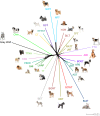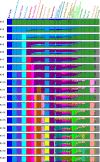Population structure and genetic history of Tibetan Terriers
- PMID: 31881816
- PMCID: PMC6935067
- DOI: 10.1186/s12711-019-0520-4
Population structure and genetic history of Tibetan Terriers
Abstract
Background: Tibetan Terrier is a popular medium-sized companion dog breed. According to the history of the breed, the western population of Tibetan Terriers includes two lineages, Lamleh and Luneville. These two lineages derive from a small number of founder animals from the native Tibetan Terrier population, which were brought to Europe in the 1920s. For almost a century, the western population of Tibetan Terriers and the native population in Tibet were reproductively isolated. In this study, we analysed the structure of the western population of Tibetan Terriers, the original native population from Tibet and of different crosses between these two populations. We also examined the genetic relationships of Tibetan Terriers with other dog breeds, especially terriers and some Asian breeds, and the within-breed structure of both Tibetan Terrier populations.
Results: Our analyses were based on high-density single nucleotide polymorphism (SNP) array (Illumina HD Canine 170 K) and microsatellite (18 loci) genotypes of 64 Tibetan Terriers belonging to different populations and lineages. For the comparative analysis, we used 348 publicly available SNP array genotypes of dogs from other breeds. We found that the western population of Tibetan Terriers and the native Tibetan Terriers clustered together with other Asian dog breeds, whereas all other terrier breeds were grouped into a separate group. We were also able to differentiate the western Tibetan Terrier lineages (Lamleh and Luneville) from the native Tibetan Terrier population.
Conclusions: Our results reveal the relationships between the western and native populations of Tibetan Terriers and support the hypothesis that Tibetan Terrier belongs to the group of ancient dog breeds of Asian origin, which are close to the ancestors of the modern dog that were involved in the early domestication process. Thus, we were able to reject the initial hypothesis that Tibetan Terriers belong to the group of terrier breeds. The existence of this native population of Tibetan Terriers at its original location represents an exceptional and valuable genetic resource.
Conflict of interest statement
The authors declare that they have no competing interests.
Figures






References
-
- Morris D. Dogs: the ultimate dictionary of over 1000 dog breeds. North Pomfret: Trafalgar Square Publishing Inc.; 2002.
-
- Cunliffe J. Tibetan terrier. Dorking: Interpret Publishing; 2006.
-
- Mathiasen H. Tibetan terriers—the little people. Svendborg: Tryk-Team; 2006.
MeSH terms
Grants and funding
LinkOut - more resources
Full Text Sources

